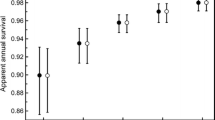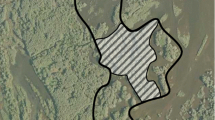Abstract
Theories of ageing predict that early reproduction should be associated with accelerated reproductive senescence and reduced longevity. Here, the influence of age of first reproduction on reproductive senescence and lifespan, and consequences for lifetime reproductive success (LRS), were examined using longitudinal reproductive records of male and female blue-footed boobies (Sula nebouxii) from two cohorts (1989 and 1991). The two sexes showed different relationships between age of first reproduction and rate of senescent decline: the earlier males recruited, the faster they experienced senescence in brood size and breeding success, whereas in females, recruiting age was unrelated to age-specific patterns of reproductive performance. Effects of recruiting age on lifespan, number of reproductive events and LRS were cohort- and/or sex-specific. Late-recruiting males of the 1989 cohort lived longer but performed as well over the lifetime as early recruits, suggesting the existence of a trade-off between early recruitment and long lifespan. In males of the 1991 cohort and females of both cohorts, recruiting age was apparently unrelated to lifespan, but early recruits reproduced more frequently and fledged more chicks over their lifetime than late recruits. Male boobies may be more likely than females to incur long-term costs of early reproduction, such as early reproductive senescence and diminished lifespan, because they probably invest more heavily than females. In the 1991 cohort, which faced the severe environmental challenge of an El Niño event in the first year of life, life-history trade-offs of males may have been masked by effects of individual quality.



Similar content being viewed by others
References
Ahnesjö I, Kvarnemo C, Merilaita S (2001) Using potential reproductive rates to predict mating competition among individuals qualified to mate. Behav Ecol 12:397–401
Alonso-Alvarez C, Bertrand S, Devevey G, Prost J, Faivre B, Chastel O, Sorci G (2006) An experimental manipulation of life-history trajectories and resistance to oxidative stress. Evolution 60:1913–1924
Anderson DJ (1989) Differential responses of boobies and other seabirds in the Galápagos to the 1986–87 El Niño Southern Oscillation event. Mar Ecol Prog Ser 52:209–216
Anderson DJ, Ricklefs RE (1992) Brood size and food provisioning in masked and blue-footed boobies (Sula spp.). Ecology 73:1363–1374
Beamonte-Barrientos R, Velando A, Drummond H, Torres R (2010) Senescence of maternal effects: aging influences egg quality and rearing capacities of a long-lived bird. Am Nat 175:469–480
Beckman KB, Ames BN (1998) The free radical theory of aging matures. Physiol Rev 78:547–581
Blondel J, Pradel R, Lebreton J-D (1992) Low fecundity insular blue tits do not survive better as adults than high fecundity mainland ones. J Anim Ecol 61:205–213
Bonduriansky R, Maklakov A, Zajitschek F, Brooks R (2008) Sexual selection, sexual conflict and the evolution of ageing and life span. Funct Ecol 22:443–453
Boulinier T, Sorci G, Clobert J, Danchin E (1997) An experimental study of the costs of reproduction in the kittiwake Rissa tridactyla: comment. Ecology 78:1284–1287
Cam E, Link WA, Cooch EG, Monnat J-Y, Danchin E (2002) Individual covariation in life-history traits: seeing the trees despite the forest. Am Nat 159:96–105
Castillo-Alvarez A, Chavez-Peón A (1983) Ecología reproductiva e influencia del comportamiento en el control del número de crias en el bobo de patas azules, Sula nebouxii, en la Isla Isabel, Nay. BSc Thesis, Universidad Nacional Autonoma de Mexico, Mexico
Charmantier A, Perrins C, McCleery RH, Sheldon BC (2006) Quantitative genetics of age at reproduction in wild swans: support for antagonistic pleiotropy models of senescence. Proc Natl Acad Sci USA 103:6587–6592
Crawley MJ (2007) The R book. Wiley, Chichester
Dentressangle F, Boeck L, Torres R (2008) Maternal investment in eggs is affected by male feet colour and breeding conditions in the blue-footed booby, Sula nebouxii. Behav Ecol Sociobiol 62:1899–1908
Descamps S, Boutin S, Berteaux D, Gaillard J-M (2008) Age-specific variation in survival, reproductive success and offspring quality in red squirrels: evidence of senescence. Oikos 117:1406–1416
Drummond H, Osorno JL, García C, Torres R, Merchant H (1991) Sexual dimorphism and sibling competition: implications for avian sex ratios. Am Nat 138:623–641
Drummond H, Torres R, Krishnan VV (2003) Buffered development: resilience after aggressive subordination in infancy. Am Nat 161:794–807
Evans RM (1990) The relationship between parental input and investment. Anim Behav 39:797–798
Fordyce JA (2006) The evolutionary consequences of ecological interactions mediated through phenotypic plasticity. J Exp Biol 209:2377–2383
Forslund P, Pärt T (1995) Age and reproduction in birds-hypotheses and tests. Trends Ecol Evol 10:374–378
Guerra M, Drummond H (1995) Reversed sexual size dimorphism and parental care: minimal division of labour in the blue-footed booby. Behaviour 132:479–496
Gustafsson L, Pärt T (1990) Acceleration of senescence in the collared flycatcher Ficadula albicollis by reproductive costs. Nature 347:279–281
Hadley GL, Rotella JJ, Garrott RA (2007) Evaluation of reproductive costs for weddell seals in Erebus Bay, Antarctica. J Anim Ecol 76:448–458
Kim S-Y, Torres R, Rodríguez C, Drummond H (2007a) Effects of breeding success, mate fidelity and senescence on breeding dispersal of male and female blue-footed boobies. J Anim Ecol 76:471–479
Kim S-Y, Torres R, Domínguez CA, Drummond H (2007b) Lifetime philopatry in the blue-footed booby: a longitudinal study. Behav Ecol 18:1132–1138
Kim S-Y, Drummond H, Torres R, Velando A (2011) Evolvability of an avian life-history trait declines with father’s age. J Evol Biol 24:295–302
Kirkwood TBL (1977) Evolution of ageing. Nature 270:301–304
Kirkwood TBL, Rose MR (1991) Evolution of senescence-late survival sacrificed for reproduction. Philos Trans R Soc Lond B 332:15–24
Kruuk LEB, Slate J, Wilson AJ (2008) New answers for old questions: the evolutionary quantitative genetics of wild animal populations. Annu Rev Ecol Evol Syst 39:525–548
Lindström J (1999) Early development and fitness in birds and mammals. Trends Ecol Evol 14:343–348
Medawar PB (1952) An unsolved problem of biology. Lewis, London
Metcalfe NB, Monaghan P (2001) Compensation for a bad start: grow now, pay later? Trends Ecol Evol 16:254–260
Michener GR, Locklear L (1990) Differential costs of reproductive effort for male and female Richardson’s ground squirrels. Ecology 71:855–868
Monaghan P, Nager RG, Houston DC (1998) The price of eggs: increased investment in egg production reduces the offspring rearing capacity of parents. Proc R Soc Lond B 265:1731–1735
Moyes K, Morgan BJT, Morris A, Morris SJ, Clutton-Brock TH, Coulson T (2009) Exploring individual quality in a wild population of red deer. J Anim Ecol 78:406–413
Nelson JB (2005) Pelicans Cormorants and their relatives. Oxford University Press, Oxford
Newton I (1985) Lifetime reproductive output of female sparrowhawks. J Anim Ecol 54:241–253
Nussey DH, Kruuk LEB, Donald A, Fowlie M, Clutton-Brock TH (2006) The rate of senescence in maternal performance increases with early-life fecundity in red deer. Ecol Lett 9:1342–1350
Nussey DH, Coulson T, Festa-Bianchet M, Gaillard J-M (2008) Measuring senescence in wild animal populations: towards a longitudinal approach. Funct Ecol 22:393–406
Oli MK, Hepp GR, Kennamer RA (2002) Fitness consequences of delayed maturity in female wood ducks. Evol Ecol Res 4:563–576
Oro D, Torres R, Rodriguez C, Drummond H (2010) Climatic influence on demographic parameters of a tropical seabird varies with age and sex. Ecology 91:1205–1214
Osorio-Beristain M, Drummond H (1993) Natal dispersal and deferred breeding in the blue-footed booby. Auk 110:234–239
Partridge L (1992) Lifetime reproductive success and life-history evolution. In: Newton I (ed) Lifetime reproduction in birds. Academic, London, pp 421–440
Partridge L, Farquhar M (1981) Sexual activity reduces lifespan of male fruitflies. Nature 294:580–582
Pyle P, Nur N, Sydeman WJ, Emslie SD (1997) Cost of reproduction and the evolution of deferred breeding in the western gull. Behav Ecol 8:140–147
R Development Core Team (2008) R: A language and environment for statistical computing. R Foundation for Statistical Computing, Vienna. ISBN 3-900051-07-0. http://www.R-project.org
Reed ET, Gauthier G, Pradel R, Lebreton J-D (2003) Age and environmental conditions affect recruitment in greater snow geese. Ecology 84:219–230
Reed ET, Kruuk LEB, Wanless S, Frederiksen M, Cunningham EJA, Harris MP (2008) Repoductive senescence in a long-lived seabird: rates of decline in late-life performance are associated with varying costs of early reproduction. Am Nat 171:E89–E101
Reid JM, Monaghan P, Ruxton GD (2002) Males matter: the occurrence and consequences of male incubation in starlings (Sturnus vulgaris). Behav Ecol Sociobiol 51:255–261
Reid JM, Bignal EM, Bignal S, McCracken DI, Monaghan P (2003) Age-specific reproductive performance in red-billed choughs Pyrrhocorax pyrrhocorax: patterns and processes in a natural population. J Anim Ecol 72:765–776
Reznick D, Nunney L, Tessier A (2000) Big houses, big cars, superfleas and the costs of reproduction. Trends Ecol Evol 15:421–425
Rice WR, Chippindale AK (2001) Intersexual ontogenetic conflict. J Evol Biol 14:685–693
Roff DA (2002) Life history evolution. Sinauer, Sunderland
SAS Institute (1999) SAS/STAT, version 8. SAS Institute, Cary
Schaffer WM (1974) Selection for optimal life histories: the effects of age structure. Ecology 55:291–303
Sedinger JS, Flint PL, Lindberg MS (1995) Environmental influence on life-history traits: growth, survival, and fecundity in black brant (Branta bernicla). Ecology 76:2404–2414
Stearns SC (1992) The evolution of life histories. Oxford University Press, Oxford
Tavecchia G, Pradel R, Boy V, Johnson AR, Cézilly F (2001) Sex- and age-related variation in survival and cost of first reproduction in greater flamingos. Ecology 82:165–174
Torres R, Drummond H (1999) Variably male-biased sex ratio in a marine bird with females larger than males. Oecologia 118:16–22
van de Pol M, Verhulst S (2006) Age-dependent traits: a new statistical model to separate within- and between-individual effects. Am Nat 167:764–771
van de Pol M, Wright J (2009) A simple method for distinguishing within versus between-subject effects using mixed models. Anim Behav 77:753–758
van Noordwijk AJ, de Jong G (1986) Acquisition and allocation of resources: their influences on variation in life history tactics. Am Nat 128:137–142
Velando A, Alonso-Alvarez C (2003) Differential body condition regulation by males and females in response to experimental manipulations of brood size and parental effort in the blue-footed booby. J Anim Ecol 72:846–856
Velando A, Drummond H, Torres R (2006a) Senescent birds redouble reproductive effort when ill: confirmation of the terminal investment hypothesis. Proc R Soc Lond B 273:1443–1448
Velando A, Beamonte-Barrientos R, Torres R (2006b) Pigment-based skin colour in the blue-footed booby: an honest signal of current condition used by females to adjust reproductive investment. Oecologia 149:535–542
Viallefont A, Cooch EG, Cooke F (1995) Estimation of trade-offs with capture-recapture models: a case study on the lesser snow goose. J Appl Stat 22:847–861
Williams GC (1957) Pleiotropy, natural selection and the evolution of senescence. Evolution 11:398–411
Acknowledgments
We thank P. Monaghan and N. Metcalfe for very helpful comments on an earlier manuscript, J. Stamps for references and discussion, and C. Rodríguez, J. L. Osorno and numerous volunteers and students for dedicated work in the field and on the database. Annual fieldwork on Isla Isabel depended on the generous support of many fishermen, the Mexican Secretaría del Medioambiente y Recursos Naturales and the Mexican navy. Finance was provided by the Mexican Consejo Nacional de Ciencia y Tecnología (4722-N9407, C01-47599, D112-903581, PCCNCNA-031528), the Universidad Nacional Autónoma de México (IN211491), the National Geographic Society (3065-85, 4535-91), and the Conservation and Research Foundation. S.-Y. Kim was supported by a postdoctoral fellowship of the UNAM and by the Spanish Ministerio de Ciencia y Tecnología (CGL2006-10357-C02-01/BOS) and the Xunta de Galicia (Isidro Parga Pondal fellowship). The field procedures we performed did not involve any licensed procedures and complied with the current laws of Mexico.
Author information
Authors and Affiliations
Corresponding author
Additional information
Communicated by Christopher Johnson.
Rights and permissions
About this article
Cite this article
Kim, SY., Velando, A., Torres, R. et al. Effects of recruiting age on senescence, lifespan and lifetime reproductive success in a long-lived seabird. Oecologia 166, 615–626 (2011). https://doi.org/10.1007/s00442-011-1914-3
Received:
Accepted:
Published:
Issue Date:
DOI: https://doi.org/10.1007/s00442-011-1914-3




